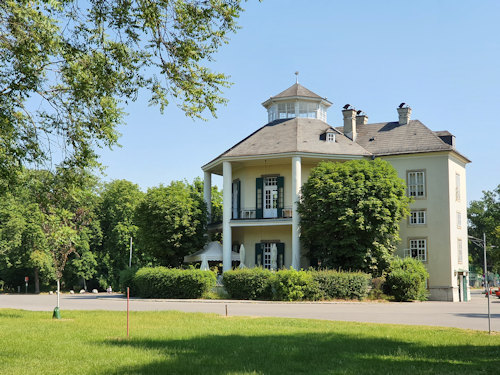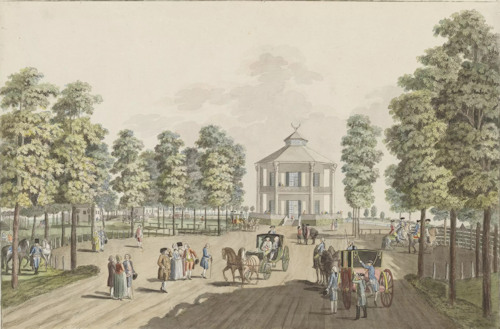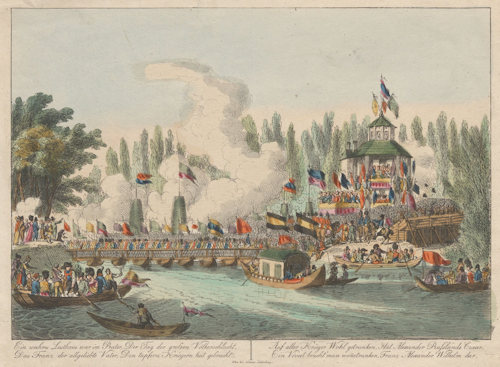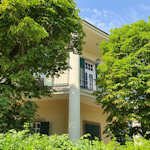The Habsburgs had quite a few little places in the country (many not so little). One of them, the Lusthaus, still stands in the middle of the Prater park and recreational area.
- Imperial summer house dating back to the 18th century
- Famously hosted the monarchs of Europe in 1814 to celebrate the Battle of Leipzig
- Now a restaurant
- See also:
A royal summer house

(The Lusthaus as it looks today)
Back in the day, Vienna’s Prater park was not for mere mortals like you and me. This was a playground of the emperor and his associates, particularly for a spot of Imperial hunting.
Of course, your average emperor felt that a picnic blanket and a couple of cheese sandwiches failed to do justice to the magnificence of the royal self when out and about in nature.
As a consequence, monarchs would often put up suitably-impressive buildings for rest and relaxation after a hard morning butchering the local wildlife.
The word Lusthaus, for example, refers to a kind of small summer house (and a Lustschloss to a larger more palatial alternative). And just such a Lusthaus went up in the Prater in the mid-1500s.
That original building is no more, but a “new” one appeared in 1783 during the reign of Emperor Joseph II. He was remarkably enlightened for the era, enacting numerous progressive reforms such as an end to serfdom. Joseph, in fact, first opened up the Prater area to the public in 1766.

(The “new” Lusthaus in the Prater, painted by Johann Andreas Ziegler and published by Artaria & Co. Verlag in 1783; Wien Museum Inv.-Nr. 94373; excerpt reproduced with permission under the terms of the CC0 licence)
That Lusthaus remains, situated at the far end of the Hauptallee: the 4.4km long, tree-lined avenue (itself dating back to the early 16th century) that begins at the main entrance to the park.
(Although today’s building looks like the original, much of the structure is actually relatively new. World War II damage meant significant parts had to be reconstructed.)
True to its name, the location served through the years as a host for various forms of gentle leisure and entertainment, for example as an upmarket restaurant or a venue for certain annual festivities. That tradition continues today with the Café-Restaurant Lusthaus.
Perhaps most famously, the Lusthaus hosted the 1814 first anniversary celebrations of the Battle of Leipzig. That conflict saw the defeat of Napoleon by an alliance of Austria, Prussia, Sweden and Russia, essentially marking the beginning of the end for the French emperor.
Napoleon suffered very few defeats in his lifetime, so the Leipzig one seemed worthy of appropriate celebration.

(An engraving by Johann Schönberg from 1814 depicting imperial celebrations at the Lusthaus; Wien Museum Inv.-Nr. 199192; excerpt reproduced with permission under the terms of the CC0 licence)
With various monarchs already in town for the Congress of Vienna, the Austrian emperor Franz I invited them all to a huge party on October 18th, along with thousands of soldiers. Much carousing was no doubt in evidence.
Many works of art commemorate the event, such as the one pictured above. The etching also reveals that an arm of the Danube once passed directly by the Lusthaus.
(Before major regulation of the waterways, the Danube used to shift about inconveniently; historical images often show bits of the river that no longer appear in the same location.)
How to get to the Lusthaus
Unsurprisingly, given the park location, the Lusthaus does not adjoin a subway or tram line. You can, of course, walk up to it from the Praterstern station (U1 and U2 subway) at the start of the Prater or from one of the subway stations that flank the park: Donaumarina (U2) or Erdberg (U3), for example.
A road connection does exist, and the 77A bus stops right outside. Catch the bus, for example, from the Donaumarina subway station on the U2 or the Schlachthausgasse station on the U3.
The building actually lies on one of the official city hiking trails (number 9) that encircles the Prater, so you might take it in as part of a wider walk.
Address: Freudenau 254, 1020 Vienna
